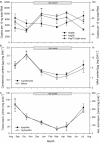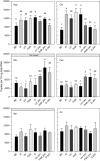Seasonal plasticity in photoprotection modulates UV-induced hsp gene expression in copepods from a clear lake
- PMID: 30333668
- PMCID: PMC6175331
- DOI: 10.1002/lno.10793
Seasonal plasticity in photoprotection modulates UV-induced hsp gene expression in copepods from a clear lake
Abstract
Zooplankton from clear alpine lakes is exposed to stressful levels of solar UV radiation (UVR). As these pelagic organisms experience high UVR and large changes in solar radiation conditions between ice-free and ice-cover periods, they have evolved various strategies to minimize UVR exposure and damage. Here, we studied the relation between photoprotection levels (mycosporine-like amino acids, carotenoids), antioxidant capacities, and gene expression of heat shock proteins (hsps) as indicator of stress in the copepod Cyclops abyssorum tatricus during the course of a year. Expression of hsp60, hsp70, and hsp90 was measured in the field (baseline expression [BE]) and after UVR exposure in the laboratory. The BE differed among genes and seasons (hsp60: high during summer, hsp70 and hsp90: high during the ice-cover period). The gene expression of hsp70 was upregulated after exposure to UVR (up to 5.2-fold change), while hsp60 and hsp90 were only constitutively expressed. A strong seasonal pattern was found in the photoprotective compounds and antioxidant capacities, with highest levels during the ice-free period. The extent of upregulation of hsp70 gene expression increased with decreasing photoprotection levels and peaked 24 h post UVR exposure (9.6-fold change) at the time of lowest photoprotection (February). Our data suggest that hsp70 gene expression is modulated by seasonal plasticity in photoprotection. This ability of adequate stress response is essential for survival in highly variable ecosystems such as alpine lakes.
Figures




Similar articles
-
Phenotypic and molecular responses of copepods to UV radiation stress in a clear versus a glacially turbid lake.Freshw Biol. 2022 Aug;67(8):1456-1467. doi: 10.1111/fwb.13953. Epub 2022 Jun 6. Freshw Biol. 2022. PMID: 36249915 Free PMC article.
-
UV-induced DNA damage in Cyclops abyssorum tatricus populations from clear and turbid alpine lakes.J Plankton Res. 2014 Mar;36(2):557-566. doi: 10.1093/plankt/fbt109. Epub 2013 Nov 11. J Plankton Res. 2014. PMID: 24616551 Free PMC article.
-
Seasonal and ontogenetic changes of mycosporine-like amino acids in planktonic organisms from an alpine lake.Limnol Oceanogr. 2006 May;51(3):1530-1541. doi: 10.4319/lo.2006.51.3.1530. Limnol Oceanogr. 2006. PMID: 21258624 Free PMC article.
-
Mycosporine-Like Amino Acids for Skin Photoprotection.Curr Med Chem. 2018;25(40):5512-5527. doi: 10.2174/0929867324666170529124237. Curr Med Chem. 2018. PMID: 28554325 Free PMC article. Review.
-
Mycosporine-Like Amino Acids: Making the Foundation for Organic Personalised Sunscreens.Mar Drugs. 2019 Nov 12;17(11):638. doi: 10.3390/md17110638. Mar Drugs. 2019. PMID: 31726795 Free PMC article. Review.
Cited by
-
Phenotypic and molecular responses of copepods to UV radiation stress in a clear versus a glacially turbid lake.Freshw Biol. 2022 Aug;67(8):1456-1467. doi: 10.1111/fwb.13953. Epub 2022 Jun 6. Freshw Biol. 2022. PMID: 36249915 Free PMC article.
-
Mycosporine-Like Amino Acids (MAAs) in Zooplankton.Mar Drugs. 2020 Jan 23;18(2):72. doi: 10.3390/md18020072. Mar Drugs. 2020. PMID: 31979234 Free PMC article. Review.
-
Contrasting diurnal patterns in antioxidant capacities, but not in expression of stress protein genes among copepod populations from clear versus glacially fed alpine and subalpine lakes.J Plankton Res. 2019 Nov;41(6):897-908. doi: 10.1093/plankt/fbz061. Epub 2019 Dec 10. J Plankton Res. 2019. PMID: 31920209 Free PMC article.
References
-
- Altschul, S. F. , Gish W., Miller W., Myers E. W., and Lipman D. J.. 1990. Basic local alignment search tool. J. Mol. Biol. 215: 403–410. doi:http://10.1016/S0022-2836(05)80360-2 - DOI - PubMed
-
- Aruda, A. M. , Baumgartner M. F., Reitzel A. M., and Tarrant A. M.. 2011. Heat shock protein expression during stress and diapause in the marine copepod Calanus finmarchicus . J. Insect Physiol. 57: 665–675. doi:http://10.1016/j.jinsphys.2011.03.007 - DOI - PubMed
-
- Belzile, C. , Gibson J. A. E., and Vincent W. F.. 2002. Colored dissolved organic matter and dissolved organic carbon exclusion from lake ice: Implications for irradiance transmission and carbon cycling. Limnol. Oceanogr. 47: 1283–1293. doi:http://10.4319/lo.2002.47.5.1283 - DOI
-
- Bligh, E. G. , and Dyer W. J.. 1959. A rapid method for total lipid extraction and purification. Can. J. Biochem. Physiol. 37: 911–917. doi:http://10.1139/o59-099 - DOI - PubMed
-
- Boulangé‐Lecomte, C. , Forget‐Leray J., and Xuereb B.. 2014. Sexual dimorphism in Grp78 and Hsp90A heat shock protein expression in the estuarine copepod Eurytemora affinis . Cell Stress Chaperones 19: 591–597. doi:http://10.1007/s12192-013-0482-3 - DOI - PMC - PubMed
LinkOut - more resources
Full Text Sources
Research Materials
Miscellaneous
